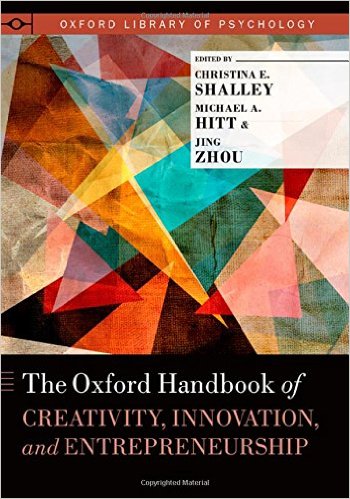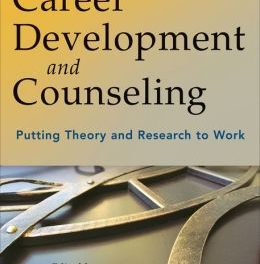A Volume in the Oxford Library of Psychology Series
Editors: Christina A. Shalley, PhD; Michael A. Hitt, PhD; and Jing Zhou, PhD
Publisher: Oxford University Press – 540 pages
Book Review by: Sonu Chandiram
Research has been going on around the world separately on creativity, innovation, and entrepreneurship. Many subjects, topics, ideas and other aspects of these three research areas intersect. This book points out to the critical need to, and shows ways to integrate the literature in these three interrelated areas.
Sixty-five scholars of business, economics, management, psychology, sociology and related fields from the United States and 11other countries – Australia, Austria, Canada, China, France, Greece, Hong Kong, the Netherlands, Norway, Spain, the United Kingdom – wrote the 29 chapters of this book that are organized around these three basic parts:
- Organizational Creativity
- Innovation
- Creativity
Materials in the chapters are organized systematically into these main components:
- Chapter title
- Bylines
- Abstract
- Key words
- Topic Discussions
- Subtopic Discussions
- Conclusion, or
- Areas of Future Research
- References
The chapters basically examine where and how topics touch or overlap in creativity, innovation, and entrepreneurship, and how research findings in these three areas can be synthesized, as well as utilized to stimulate further interdisciplinary investigation and provide direction for integration. The ultimate purpose of such efforts is to enhance an organization’s ability to navigate in the present-day competitive business environment.
A good way to illustrate the value of what you will find in this unique book is to take a look at chapter 18, Business Innovation Processes.
This chapter’s authors – Raghu Garud, Philipp Tuertscher, and Andrew H. Van de Ven – begin by describing in the Abstract the processes of innovation in business by stating that they are an ongoing set of activities comprising of:
- Invention
- Development
- Implementation
Note the emphasized word ongoing. One critical characteristic of successful companies is that they never stop innovating. Usually it is the owner or founder or chief executive who comes up with ideas for new products or services, but he usually sets an example for others, and oftentimes challenges them to come up with novel products that can save time, money or effort. New products must solve existing problems to be marketable.
For example, in a recent episode of the TV show Shark Tank, a group of entrepreneurs came up with an expandable shoe. This shoe helped save money for parents of kids in an African country whose feet grow fast and they need to buy new pairs of shoes in short periods of time.
The authors explain further the processes of innovation: “Invention implies the emergence of novel ideas of potential value. However, to realize this potential, ideas have to be developed, a process that requires both their instantiation in the form of prototypes and the creation of an infrastructure to generate value in use. In addition, the implementation of innovations (i.e. their widespread adoption) requires additional efforts.”
“After the explication of these three elements of innovation processes, the complexities involved are highlighted. In particular, innovation processes do not progress in a neat, linear fashion from invention to development and implementation, but instead are characterized by considerable shifts between these elements. The chapter concludes by highlighting implications for practice.”
The authors then lay out the findings of the Minnesota Innovation Research Program (MIRP) which examined how innovation processes unfold in a variety of settings. In this program, Van de Ven, Polley, Garud and Venkataraman found, in 1999, a dozen common characteristics that occurred during the invention, development, and implementation stages of the innovation journey.
They present these in a detailed chart on page 340. This chart shows Investors / Top Management, Relationships with Others, and Infrastructure Development as three elements across the top; and Gestation, Shock, and Fluid Participation of Organizational Personnel at the base of the chart. Within the body of the chart are the myriad interactions of other elements: Proliferation, Plans, Setback, and Criteria Shift. These interactions end either in Adoption of the idea for a product or Termination. However if a product is not created, it does not mean that it cannot be modified and eventually created.
This is an excellent book for any entrepreneur or anyone else who wants to learn the process of innovation.
Editors:
Christina A. Shalley. PhD is the Thomas R. Williams – Wells Fargo Professor of Organizational Behavior at the Georgia Institute of Technology’s Scheller College of Business. Her research focuses on the effects of various social and contextual factors in enhancing creativity for both individuals and teams of employees. She is co-editor of the Handbook of Organizational Creativity.
Michael A. Hitt, PhD is a Distinguished Professor at Texas A&M University, where he holds the Joe B. Foster in Business Leadership. He has co-authored or co-edited 27 books and authored or coauthored many journal articles. In 2014 he was listed as a Thomson Reuters Highly Cited Researcher and as one of the World’s Most Influential Scientific Minds.
Jing Zhou, PhD is the Houston Endowment Professor of Management and the Director for Asian Management Research and Education at Rice University’s Jesse H. Jones Graduate School of Business. Her research centers on creativity in the workplace. She has been elected a Fellow of the American Psychological Association, the Association of Psychological Sciences, and the Society for Industrial and Organizational Psychology.







